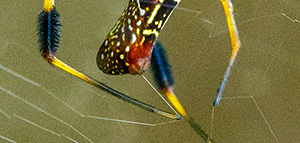Spiders and STEM
Today, Spiders and STEM education. The University of Houston presents this series about the machines that make our civilization run and the people whose ingenuity created them.
Here's a fine old book. It's Arabella Buckley's Life and Her Children. Buckley knew the great biologists of her day - Darwin, Lyell, and more. She worked for Lyell until he died. Then she began writing science books for young people. Today we talk about STEM education - Science, Technology, Engineering, and Math. Well, this was STEM back in the 19th Century. So, let's open her book:

She begins by asking us to look at the family bond that unites all living things. She wants us to see how we're all interconnected. The deeply religious Buckley revels in the miracle of evolution. She describes our wondrously evolved biosphere.
Let's look at her chapter on "Snare Weavers." Mostly, that means spiders. Of course, spiders make many of us cringe! But Buckley knew that children haven't yet learned to be frightened. They can still see a spider for what it really is - a creature of tenacity and amazing skill. I think there's something here to bear in mind as we weigh our own STEM tactics.

Buckley begins with a garden spider's body - its jaws, torso, eight legs, and more. Its six spinnerets are fascinating. She tells how each puts out a different filament: Strong structural threads anchor the web. Then radial spokes. Stretchy winding threads circle the spokes. (They're the ones that carry tiny adhesive blobs to snare insects.) We learn how spiders capture, then consume, their prey.

It's all so wonderfully complete. Still ... more recent research has shown just how strong spider silk is. To break it, takes several times the yield stress of common steel. But, unlike steel, it easily deforms. Then it creeps back to its original shape. That way, insects can't trampoline off a thread once they've landed on it.
I'm really surprised she could already tell us that each spider thread is a structure - not a single thread of material. Each spinneret puts out hundreds of incredibly small threads. They give the visible thread its underlying structure.
Buckley finishes by saying, "Thus the 8-legged insects ... make good their right to live ... If we could watch them all in their daily labour, we should find them quite as active and industrious as [we ourselves] ... struggling far more bravely against the thousand dangers and privations which threaten them every moment ... "

And so, Arabella Buckley has used this once maligned creature to capture the young imagination. She teases young people to ask still more questions. Today, we wonder how to make our STEM education work. Well, here's an idea. Let's not be afraid to engage them with slightly scary themes. But frame them so they trigger curiosity. I think you'll agree. If we can lay aside our own fears, then nature's complexities have so much to teach us all - young and old alike.
I'm John Lienhard at the University of Houston, where we're interested in the way inventive minds work.
Buckley, Arabella B., Life and Her Children. (London: Edward Stanford, Charing Cross, 1892) (The author's Preface is signed 1880.) She includes this verse on the back of her Title page:
................'His parent hand,
From the mute shell-fish gasping on the shore,
To men, to angels, to celestial minds,
For ever leads the generations on
To higher scenes of being; while supplied
From day to day with his enlivening breath,
Inferior orders in succession rise To fill the void below. ..............Akenside. Pleasures of the Imagination
E. B. White, Charlotte's Web (Harper and Bros. 1952) This book, written in storybook style, carries on Arabella Buckley's mission. It's a children's favorite that's extremely accurate in describing a spider's (Charlotte's) means for dealing with her world.
For more on spider behavior, see Episodes 2470 and 1069. For more about "spider silk", see Episodes 1717, 2435, and 2996.
See my slide show here, of my own spider photos (if you're up for such images): The photographs above are from this source.
For up-to-date scientific information I suggest the Wikipedia articles on Spiders, Spider Silk, Arabella Buckley, Charles Lyell, and other related topics.
This episode was first aired on December 12, 2022.